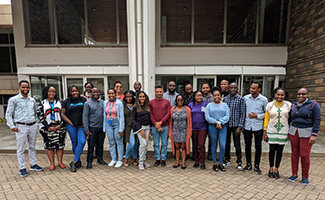
The Section of Genomic Epidemiology and Evolution of Pathogens (GEEP) at DIEPS, FIC, NIH leads a capacity-building program toward real-time genomic surveillance and phylodynamic analysis of emerging infectious diseases for low-resource settings. The threat of major pathogen outbreaks is high and alarming, particularly in low- and middle-income countries (LMICs) that might not have as robust surveillance and reporting infrastructure. Therefore, gaining insight into the pathogens circulating locally provides the global public health community with comprehensive knowledge of the current circulating diversity for improved preparedness and coordinated implementation of control strategies.
Our Capacity-Building in Genomic Surveillance and Epidemiology program aims to build genomic surveillance using portable and affordable sequencing such as the Oxford Nanopore Technologies MinION platform and bioinformatics and phylodynamics modeling capabilities to enable a more efficient response to disease outbreaks. Ultimately, this program addresses the need to build sustainable capacity for real-time genomic surveillance and characterization of emerging disease threats globally while promoting biosecurity in a time of rapidly changing technological capabilities.
Projects
Beginner’s Genomic Epidemiology Workshop
Topics covered:
- Sequence generation using Oxford Nanopore Technologies
- Bioinformatics pipelines to generate consensus sequences (used in downstream analysis)
- Multiple sequence alignments, compilation of genomic background datasets, reconstruction of maximum-likelihood phylogenetic trees
- Interpretation of phylogenies to inform public health action
Genomic Epidemiology for Public Health Laboratories
Topics covered:
- Study design for appropriate implementation of surveillance
- Sequence generation using Oxford Nanopore Technologies
- Bioinformatics pipelines to generate consensus sequences (used in downstream analysis)
- Multiple sequence alignments, compilation of genomic background datasets, reconstruction of maximum-likelihood phylogenetic trees
- Interpretation of phylogenies to inform public health action
Advanced Genomic Epidemiology
Topics covered:
- Bayesian phylodynamics using the Bayesian Evolutionary Analysis Sampling Trees (BEAST) framework
- Examination of the temporal signal of a data set and identification of problematic or erroneous sequences using TempEst
- Estimation of pathogens’ evolutionary rate and reconstruction of time-stamped phylogenies using heterochronous data
- Phylogeographic diffusion in discrete and continuous space
- Interpretation of estimated parameters to gain insight into when variants emerged, from where variants were introduced, routes of transmission dynamics, the extent of cryptic transmission
Publications
-
Evolutionary history and introduction of SARS-CoV-2 Alpha VOC/B.1.1.7 in Pakistan through international travelers, featuring Fogarty's Nídia S Trovão, Zeba Rasmussen, and David J Spiro
Virus Evolution, March 17, 2022 -
Epidemiology and genetic diversity of SARS-CoV-2 lineages circulating in Africa, featuring Fogarty's David J Spiro and Nídia S Trovão as co-authors
iScience, February 5, 2022 -
Genetic and evolutionary analysis of SARS-CoV-2 circulating in the region surrounding Islamabad, Pakistan, featuring Fogarty's Joshua L. Cherry as lead author
Infect Genet Evol., July 14, 2021
Contact
Members
- Nídia S. Trovão
- Sana Tamim
Events
Upcoming Workshops
Spring 2023
Workshop: Phylodynamic modeling for Genomic Epidemiology
Location: Bangladesh
Past Workshops
September 2022
Workshop: Phylogenetics for Genomic Epidemiology
Location: Bangladesh (Virtual Workshop)
July 2022
Workshop: Advanced Bioinformatics Training Workshop
Location: Abu Dhabi, UAE
March 2022
Workshop: Implementation of Oxford Nanopore Sequencing to Improve Infectious Disease Detection, Diagnosis, and Response
Location: Pakistan (Virtual Workshop)
October-November 2021
Workshop: Implementation of Oxford Nanopore Sequencing to Improve Infectious Disease Detection, Diagnosis, and Response - Advanced Genomic Epidemiology Workshop
Location: Pakistan (Virtual Workshop)